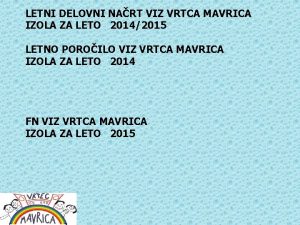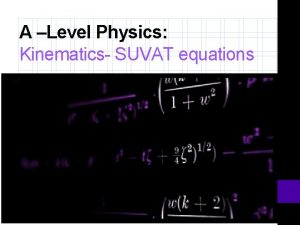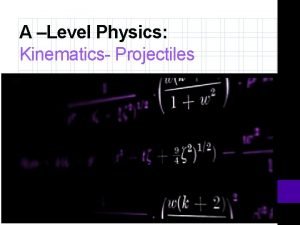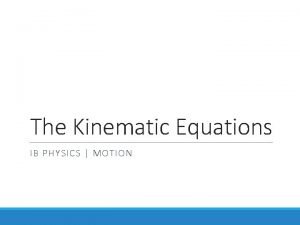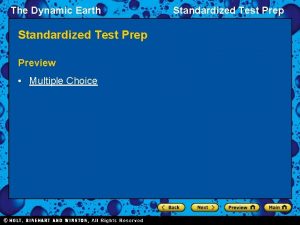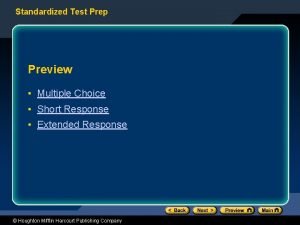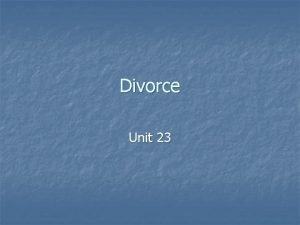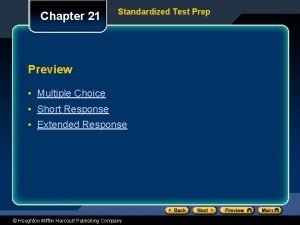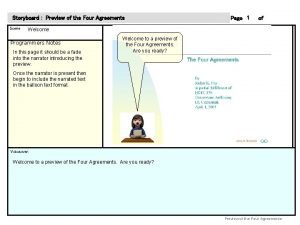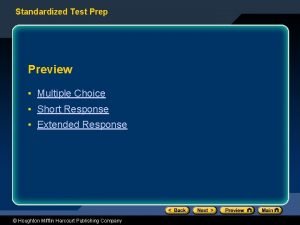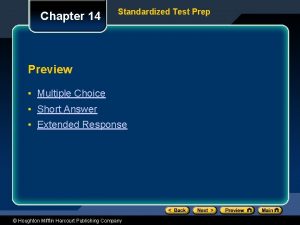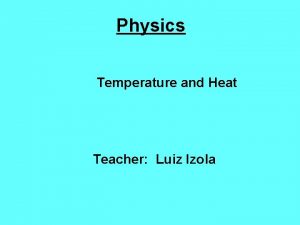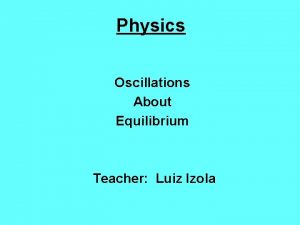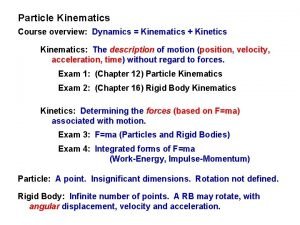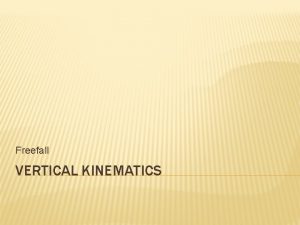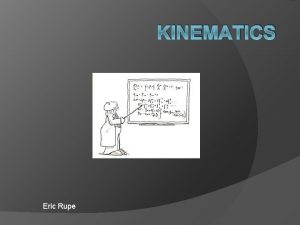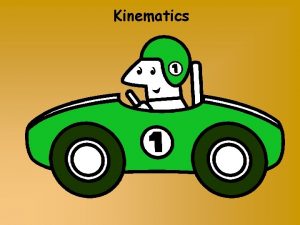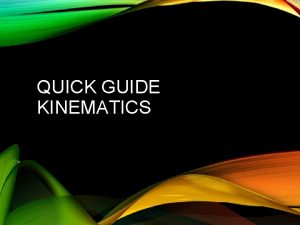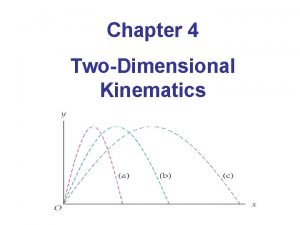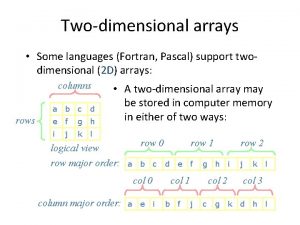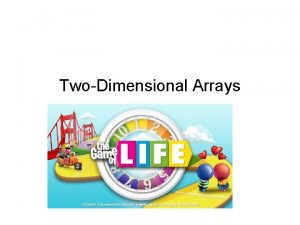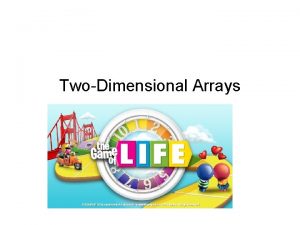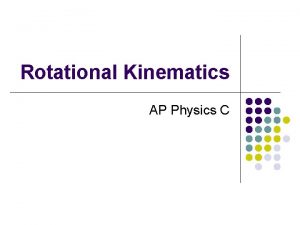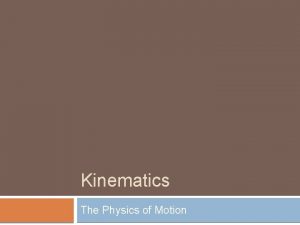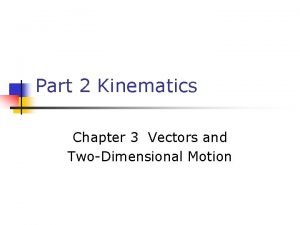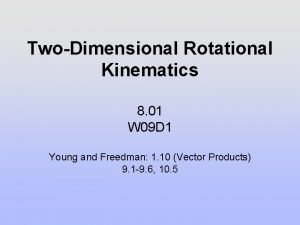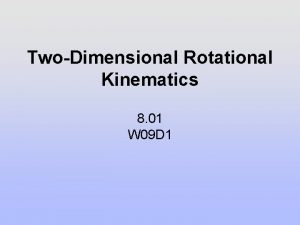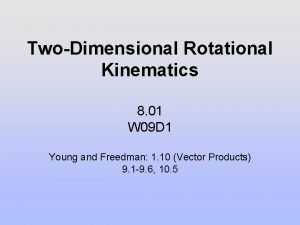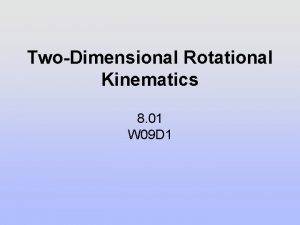Physics TwoDimensional Kinematics Teacher Luiz Izola Chapter Preview
































- Slides: 32

Physics Two-Dimensional Kinematics Teacher: Luiz Izola

Chapter Preview 1. Motion in Two Dimensions 2. Projectile Motion Basic Equations 3. Zero Launch Angle 4. General Launch Angle 5. Projectile Motion Key Characteristics

Learning Objectives Ø Apply the motion formulas in two directions (x, y). Ø Learn how to calculate motion on projectiles Ø Learn about circular motion.

Introduction Ø This presentation will concentrate on the study of motion in 2 dimensions. Ø Particularly, we will concentrate on the study of projectile motion and circular motion. Ø Projectile motion involves the study of objects that are initially launched and continue moving under gravity’s influence.

Force and Mass Ø Chapter’s Main Idea: “Horizontal and Vertical Motions are independent. ” Ø For example: A ball thrown horizontally with a speed v continues to move with the same speed v in the horizontal direction, even as it falls with an increasing speed in the vertical direction. Ø The time of fall is the same whether a ball is dropped from rest straight down or thrown horizontally. Each motion continues independently of the other.

Motion in Two Dimensions Ø Motion with constant velocity, determining x an y as functions of time. Ex: A turtle starts at the origin at t=0 and moves with a constant speed v 0 = 0. 26 m/s as show below. How far the turtle moved in the x, y directions after 5. 0 secs?

Motion in Two Dimensions Ex 2: An eagle perched on a tree limb 19. 5 m above the water spots a fish swimming near the surface. The eagle pushes off the branch and descends toward the water. By adjusting its body in flight, the eagle maintains a constant speed of 3. 10 m/s at an angle of 200 below the horizontal. (a) How long does it take for the eagle to reach the water? (b) How long has the eagle traveled in the horizontal when it reaches the water?

Constant Acceleration To study motion with constant acceleration in two dimensions, we repeat what was done with one dimension but we create two sets of equations, one set for each dimension (x, y). Table 4 -1 Constant-Acceleration Equations of Motion Position as a function Velocity as a function of time of position x = x 0 + v 0 xt + ½ axt 2 vx = v 0 x + axt vx 2 = v 0 x 2 + 2 ax. Dx y = y 0 + v 0 yt + ½ ayt 2 vy = v 0 y + ayt vy 2 = v 0 y 2 + 2 ay. Dx

Constant Acceleration Ex: A hummingbird is flying in such a way that it is initially moving vertically with a speed of 4. 6 m/s and accelerating horizontally at 11 m/’s 2. Assuming the bird’s acceleration remains constant for the time interval of interest, find the horizontal and vertical distance through which it moves in 0. 55 s.

Projectile Motion Basic Equations Ø A projectile is an object that is thrown, kicked, batted, or launched into motion and allowed to follow a path solely determined by the influence of gravity. Ø In studying projectile motion, we make the following assumptions: I. Air resistance is ignored II. The acceleration of gravity, g =9. 8 m/s 2, and is constant and downward. III. The Earth’s rotation is ignored.

Projectile Motion Basic Equations Ø Suppose, in the figure below, that the x-axis is the horizontal and the y-axis is the vertical, with the positive direction upward. All objects in free fall have ax = 0 and ay = -g. Since the downward direction is negative, it follows that: ay = 9. 81 m/s 2 = -g

Projectile Motion Basic Equations Ø Gravity cause no acceleration in the x direction. ax = 0 Ø With these acceleration components placed into the fundamental acceleration equations of motion, we have: x = x 0 + v 0 xt vx = v 0 x vx 2 = v 0 x 2 y = y 0 + v 0 yt - ½gt 2 vy = v 0 y -gt vy 2 = v 0 y 2 - 2 g. Dy

Zero Launch Angle Ø A special case is a projectile launched horizontally, so that the angle between the initial velocity and the horizontal is Θ = 0. Equations of Motion: Ø Choosing ground level to be y = 0 and the release point to be directly above the origin, the initial position of the ball is given by: x 0 = 0 y 0 = 0

Zero Launch Angle Ø Ø The initial velocity is horizontal, corresponding to Θ = 0, see figure next slide. As a result, the x component of the initial velocity is simply the initial speed, v 0 x = v 0 cos(Θ) = v 0 And the y component: v 0 y = v 0 sin(Θ) = 0 Replacing these values in the motion formulas we have: x = v 0 t vx = v 0 vx 2 = v 02 y = h - ½gt 2 vy = -gt vy 2 = - 2 g. Dy

Zero Launch Angle

Zero Launch Angle Ex: A person walking with a speed of 1. 30 m/s releases a ball from a height of 1. 25 m above the ground. Given that x 0 = 0 and y 0 = h = 1. 25 m, find x and y for (a) t = 0. 250 s and (b) t = 0. 50 s. (c) Find the velocity, speed, and direction of the ball at t = 0. 50 s. (d) How long does it take for the ball to land?

Parabolic Path and Landing Site Ø The curved path of the projectile can be found by combining the following: x = v 0 t and h = -gt 2 Ø This will give: y = h – 1/2 g(x/v 0)x 2 Ø Where does a projectile land if it is launched horizontally with speed v 0 from a height h? By setting y = 0 in the above equation, we have: x = v 0 (2 h/g)

Parabolic Path and Landing Site Ex: A mountain climber encounters a crevasse in an ice field. The opposite side of the crevasse is 2. 75 m lower, and is separated horizontally by a distance of 4. 10 m. To cross the crevasse, the climber gets a running start and jumps in the horizontal direction. (a) What is the minimum speed needed by the climber to safely cross the crevasse? If, instead, the climber’speed is 6. 00 m/s, (b) where does the climber land? , and (c) What is the climber’s speed at landing?

Practice Problems 1. A sailboat runs before the wind with a constant speed of 2. 8 m/s in a direction of 520 north of west. How far (a) west and (b) north has the sailboat traveled in 35 min? 2. Starting from rest a car accelerates at 2. 0 m/s 2 up a hill that is inclined 5. 50 above the horizontal. How far (a) horizontally, and (b) vertically has the car traveled in 12 s?

General Launch Angle Ø Consider now, the case of a projectile launched at an arbitrary angle with respect to the horizontal. To simplify the resulting equation, we take the launching site to be the origin.

General Launch Angle Since the projectile starts at the origin, we have: x 0 = y 0 = 0 The components of the initial velocity are: v 0 x = v 0 cos(Θ) v 0 y = v 0 sin(Θ) The resulting equations are: x = v 0 cos(Θ)t vx = v 0 cos(Θ) vx 2 = v 02 cos 2(Θ) y = v 0 sin(Θ) t - ½ gt 2 vy = v 0 sin(Θ) - gt vy 2 = v 02 sin 2(Θ) – 2 g. Dy

Practice Problems 1. Chipping from the rough a, a golfer sends the ball over a 3. 00 m-high tree that is 14. 0 m away. The ball lands at the same level from which it was struck after traveling an horizontal distance of 17. 8 m. (a) If the ball left the club 540 above the horizontal and landed on the green 2. 24 s later, what was its initial speed? (b) How high was the ball when it passed over the tree?

Practice Problems 2. A projectile is launched from the origin with an initial speed of 20. 0 m/s at an angel of 350 above the horizontal. Find the x, y positions of the projectile at times (a) t=0. 50 s, (b) t=1. 00 s, and (c) t = 1. 50 s. 3. A golfer hits a ball with an initial speed of 30 m/s at an angle of 500 above the horizontal. The ball lands on a green that is 5. 00 m above the level where the ball was struck. a) b) How long is the ball in the air? How far has the ball traveled in the horizontal when it lands? What is the speed and direction of motion of the ball just before it lands? c)

Practice Problems A trained dolphin leaps from the water with an initial speed of 12 m/s (see figure below). In the absence of gravity, the dolphin would move on a straight line to the ball and catch it, but because of gravity, the dolphin follows a parabolic path well below the ball’s initial position. If the trainer releases the ball the instant the dolphin leaves the water, show where the dolphin and falling ball meet.

Projectile Motion: Key Characteristics RANGE The range, R, of a projectile is the horizontal distance it travels before landing. Considering initial and final elevations the same (y = 0). Challenge: Using the assumption about y = 0 above and the following formulas of motion: y = v 0 sin(Θ) t - ½ gt 2 x = v 0 cos(Θ)t Prove that R is equals to: R = (v 02/g ). sin 2Θ

Practice Problems 1) A football game begins with a kickoff in which the ball travels a horizontal distance of 41 m. If the ball is kicked at an angle 400 above the horizontal, what was its initial speed? 2) A golf ball is struck on level ground. It lands 92. 2 m away 4. 30 s later. What was the direction and magnitude of the initial velocity? 3) The men’s world’s record for the shot put, 23. 12 m, was set by Randy Barnes of the USA on May 20, 1990. If the shot was launched from 1. 80 m above the ground at an initial angle of 420, what was the initial speed?

Maximum Height Challenge: Using the two formulas below y = v 0 sin(Θ) t - ½ gt 2 vy = v 0 y - gt Prove that the maximum height can be calculate as: h = v 0 sin(Θ) / 2 g

Practice Problems The archerfish hunts by dislodging an unsuspecting insect from its resting place with a stream of water expelled from the fish’s mouth. Suppose the archerfish squirts water with an initial speed of 2. 30 m/s at an angle of 19. 50 above the horizontal. When the stream of water reaches a beetle on the leaf at height h above the water’s surface it is moving horizontally. (a) How much time does the beetle have to react? (b) What is the beetle’s height? (c) What the horizontal distance between the beetle and the fish?

Homework I. Page 102: 11, 13, 15, 17 II. Page 103: 19, 21, 23 III. Page 104: 25 v Note: It would be excellent to try all the projectile motion problems in order to get more proficient.



 Vrtec mavrica izola
Vrtec mavrica izola Vrtec mavrica izola
Vrtec mavrica izola Aplusphysics kinematics-horizontal kinematics
Aplusphysics kinematics-horizontal kinematics A level suvat equations
A level suvat equations A level physics kinematics
A level physics kinematics Ib physics
Ib physics Kinematics physics
Kinematics physics Example of thesis statment
Example of thesis statment Summary of thesis statement
Summary of thesis statement Test prep preview
Test prep preview Test prep preview
Test prep preview Test prep preview
Test prep preview Test prep preview
Test prep preview Sccm technical preview
Sccm technical preview Startling statement introduction examples
Startling statement introduction examples Thesis and preview statement example
Thesis and preview statement example Test prep preview
Test prep preview Nnn preview
Nnn preview The selection preview
The selection preview Test prep preview
Test prep preview The four agreements preview
The four agreements preview Test prep preview
Test prep preview Line between pada perintah column digunakan untuk membuat
Line between pada perintah column digunakan untuk membuat Realistic job preview advantages and disadvantages
Realistic job preview advantages and disadvantages Test prep preview
Test prep preview Skimming newspaper
Skimming newspaper 1984 book preview
1984 book preview Https //yandex.ru/video/preview/ text
Https //yandex.ru/video/preview/ text Nút lệnh print preview nằm ở đâu
Nút lệnh print preview nằm ở đâu Tams tracks
Tams tracks Review and preview
Review and preview Realistic job preview pros and cons
Realistic job preview pros and cons Disadvantages of realistic job preview
Disadvantages of realistic job preview
